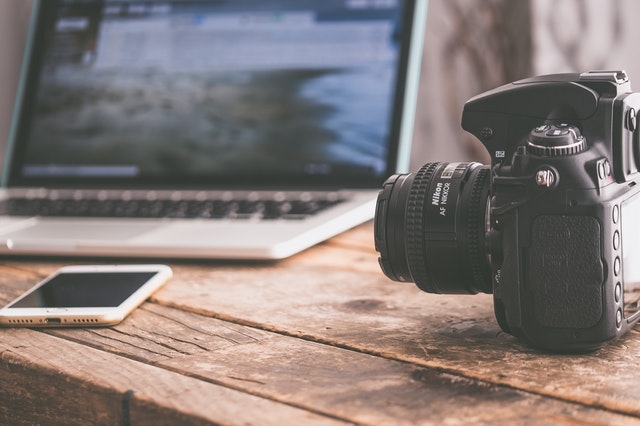The art of photography may be booming as a hobby with self-proclaimed photographers popping up on social media almost daily. The strange part of it all is that the humble camera has been left behind in the fast-paced world of interconnected imaging. While the digital camera has come on by leaps and bounds, it simply cannot compete with the ease, convenience, in device-editing and instantaneous uploads and social media sharing a Smartphone can offer.
In a time where capturing an image or moment is easy to access from your cell phone and the popularity of photography apps that set you apart from others, the world is now drowning in images. Celebrated photographers debate the impact of this mass democratisation on their craft.
Smartphone photography is growing in popularity and disrupting traditional camera use in the process.

The Smartphone has taken a large market share away from traditional cameras
How disruptive technology takes over
It is a known fact that, before smartphones hit the scene, most people found themselves without a camera during unexpected photo opportunities. But now smartphones help guarantee we always have an image-capture device at hand. It has certainly been a short leap from the once-ubiquitous photo lab to the instant selfie.
Developments in sensor and lens technology have proven that consumers are turning to smartphones more than ever before to capture moments in time, rather than picking up the traditional camera.
Features like backside-illuminated sensors and panoramic photography, most famously touted on the iPhone, have been around for a long time in traditional cameras. However, when they appear on smartphones, the world sits up and takes notice.
You could put this down to the smartphone's reach; after all, they grace most people's back pockets. Thus, increasing their favour compared to the traditional camera.
Adapt or die
Many camera companies have had to pair up with smartphones in order to get their product out there and increase sales through this new avenue. For example is the partnership between Huawei and Leica which is currently the frontrunner in having the best camera and features attached to a smartphone, making it a must-have.
The best photography-centric handsets
Listed below are some of the best camera phones with a summary of their camera features for you to choose from:
-
Samsung Galaxy S8
Camera features at a glimpse:
12mp, f/1.7 lens, 26mm equivalent, Optical Image Stabilisation (OIS), 4K video recording, MicroSD slot, raw.
-
Huawei Mate10 Pro With Leica (7)
Camera features at a glimpse:
Dual cameras 12mp colour, 20mp black and white, f/1.6 lenses, 27mm equivalent, Optical Image Stabilisation (OIS), 4K video recording, MicroSD slot, raw.
-
Apple iPhone X
Camera features at a glimpse:
Dual 12mp wide-angle and telephoto lenses, f/1.8 & f/2.4, 28mm and 56mm equivalent, Optical Image Stabilisation (OIS), 4K video recording.
-
HTC U11
Camera features at a glimpse:
12mp, f/1.7 lens, 26mm equivalent, Optical Image Stabilisation (OIS), 4K video recording, MicroSD slot, raw.
-
Samsung Galaxy S7
Camera features at a glimpse:
12mp, f/1.7 lens, 26mm equivalent, Optical Image Stabilisation (OIS), 4K video recording, MicroSD slot, raw.
-
Honor 9 Dual Camera
Camera features at a glimpse:
20mp mono camera, f/2.2 max aperture, CMOS sensor, 27mm equivalent, 4K video.
-
Samsung Galaxy S6
Camera features at a glimpse:
16mp, f/1.9 lens, 28mm equivalent, Optical Image Stabilisation (OIS), 4K video recording, raw (with update).
-
Moto G (3rd Generation)
Camera features at a glimpse:
13mp, f/2.0 lens, 28mm equivalent, FullHD video recording, MicroSD slot.
-
Apple iPhone 7 / 7 Plus
iPhone 7 Camera features at a glimpse:
12mp, f/1.8 lens, 28mm equivalent, Optical Image Stabilisation (OIS), 4K video recording, raw.
iPhone7 Plus Camera features at a glimpse:
12mp x2, 28mm f/1.8 (OIS) and 56mm f/2.8 equivalent, 4K video recording, raw.
-
HTC 10
Camera features at a glimpse:
12mp, f/1.8 lens, 26mm equivalent, Optical Image Stabilisation (OIS), 4K video recording, MicroSD slot, raw.
-
Huawei P9 - Co-engineered with Leica
Camera features at a glimpse:
2x 12mp (Colour, Black and White), f/2.2 Leica lens, 28mm equivalent, Optical Image Stabilisation (OIS), FullHD video, MicroSD slot, raw.
The Verdict
The amount of capital invested in Smartphone technology and growth potential of the industry will only see Smartphone photography improve at an exponential rate.
While there will always be a market for traditional cameras, the market for it is steadily shrinking and for those looking to survive, strategic partnerships, superior R&D and diversifying of product portfolios will be the only way they remain relevant.
In a mobile-first world of instant gratification will the traditional camera become the cassette or VHS tape of this generation? Only time will tell.
If you enjoyed this post you may like - The best photography apps to set you apart
Contact Us
If you want to know more about how mobile marketing or app development and how that can be applied to your business, feel free to contact us here
Sources: Wired, Cnet & ePhotozine
